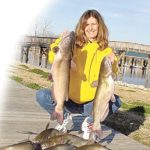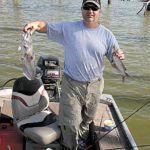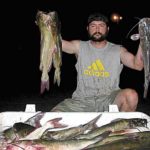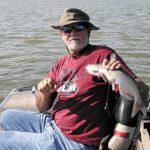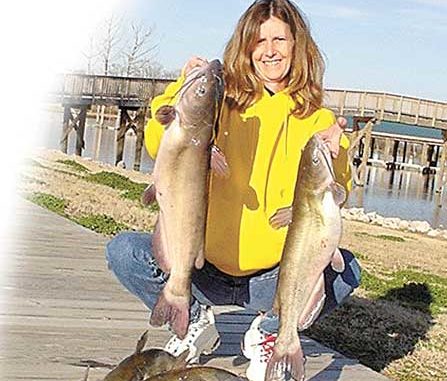
This North Louisiana lake is rich with channel cats.
When the weather starts to cool in early fall, most sportsmen hit the woods for squirrel hunting or the archery deer season. In Northeast Louisiana, however, Poverty Point Reservoir draws many outdoorsmen onto the water for some outstanding catfishing.
Poverty Point has long been a popular place to target cold-weather crappie and springtime bass, but in the last few years, it has burst on the scene as one of the state’s premier channel cat lakes.
Mike Wood, a fisheries biologist with the Louisiana Department of Wildlife and Fisheries, has worked on Poverty Point since its inception. He explained why the lake is a catfish heaven.
“It has a great phytoplankton bloom, which is millions of microscopic plants blooming,” he said. “That’s what makes the water greenish in color. Poverty Point was constructed on top of very fertile soil that is good for the phytoplankton. And since shad feed on phytoplankton, there’s a huge shad base in the lake, and that’s what the channel cats eat.”
Wood also said the channel cats have adapted well to Poverty Point because it has so little structure.
“Poverty Point has open habitat; there’s not a lot of grass or timber,” he said. “When you have open habitat and a large shad base, you wind up with lots of channel cats, crappie and yellow bass. Those are open-habitat predators, and they thrive in lakes like Poverty Point.”
The lake’s channel cats also tend to run larger than those found in other impoundments.
“They have so much to eat, they get very large,” Wood said. “We’re talking about channel cats in the 20-pound class. That’s a big channel cat.
“There’s also some good blues in there too, but not the monster-sized ones you see come out of large rivers.”
Mud cats also thrive in Poverty Point, but Opelousas, or flatheads, are less numerous. Some of the native Opelousas in Bayou Macon may have been trapped in the lake when it was impounded, but they were not part of the stocking program.
Bear in mind when fishing on Poverty Point that trotlines, jugs and yo-yos are forbidden. It is strictly a hook-and-line proposition. Wood explained, however, that this rule was not adopted as a fish-management tool.
“All of Poverty Point is a state park, and when we developed it, our feeling was you take your gear with you when you leave. That was the thinking behind the ban on jugs, trotlines and yo-yos.”
A special $6 permit is also required for night fishing, and one should remember that Poverty Point is a gated lake. At night, you can’t get back into the park if you leave after the gates are closed for the evening.
Mangham resident Walter Cotton has been fishing for Poverty Point channel cats since shortly after the lake opened. While the fish bite year around, he prefers wintertime fishing.
“I really like cold weather fishing because when the water temperature starts to drop, it begins to concentrate the cats more,” he said. “They don’t fight as hard in cold water, but you sure can catch a lot of them. I just bundle up good with the ski mask on and everything.”
Cotton’s catfish rig is simple.
“I always use a standard Carolina rig with 30-pound line, about a No. 1 swivel, and a size 3 to 8 J or circle hook,” he said. “I don’t like the circle hooks as much because the mud cats will swallow them completely. They can be a nightmare on Poverty Point. We went one time and caught 68 mud cats and just 17 channel cats in one day. I had a friend from up North, and mud cats are all they have up there. The first fish he caught on Poverty Point was a 2-pound mud cat. He was so proud, he took a roll of pictures, and refused to throw it back.”
Newcomers can do very well on the lake, Cotton said.
“First, bring a bait net, and cast around the boat ramps to catch shad,” he advised. “Cut shad is what most people use. But my favorite bait is liver. And I only use chicken liver because they don’t bite well on other types.”
As to where to fish, Cotton’s got some opinions on that as well.
“One of the best places to find channel cats is under a cormorant roost,” he said. “Some of the tall dead cypress trees are popular roosts, and the catfish will bunch under them.”
Why?
“Millions of tons of droppings that are partially digested shad,” he said. “The catfish gorge themselves on that stuff.”
One of the few places you’ll find standing timber on Poverty Point is the very northeast corner where there’s a patch of dead timber known as “the jungle.” But don’t fish in the middle of it. Cotton’s advice is to try along the timber’s edge or the open water on either side.
“There’s a ditch that runs along the south side of the jungle that I like to fish,” he said. “I was making short flipping casts along it one time, and discovered a culvert. I could feel it as the bait fell down. The first time I flipped to it, a big channel cat nailed it in about 30 seconds, and then took off just like a bass. I sat there and caught four nice ones in that one spot.”
Cotton’s favorite fishing spots are on the lake’s shallow flats.
“I usually concentrate on a couple of flats in the northeast corner near the jungle,” he said. “I call them flats because they are 5 feet deep from one end to the next, and have no structure at all.
“Also, you should concentrate on the points of land that stick out into the flats because they concentrate fish. These points are particularly good when there’s a submerged bar pit off them. The flat between the bank and the bar pit forms a natural corridor for the fish to travel along. There’s hardly any structure on Poverty Point, so you need to look for such hidden features that help concentrate the fish.
“We also do pretty good fishing along the banks around the houses on the lake’s eastern side because the water often drops off quickly to 6 feet or more. The cuts through the wind row on the eastern side are also popular with a lot of fishermen.”
One thing Cotton does not do much of is drift-fishing.
“The wind can get really bad on this lake,” he explained, “and it is rough when you’re in a small aluminum boat — particularly when it comes out of the north. It will get rough very quickly.”
On the other hand, Cotton has noticed the wind sometimes can actually be a great help.
“My favorite time to fish is when the wind is blowing straight into one of the points sticking out in the flats near the jungle,” he said. “Sometimes the harder it blows, the better they bite. If your boat is swamping, you’re in the right place. The wind, I think, drives the baitfish into the point, and the catfish feed on them.”
What is considered a good outing for catfish on Poverty Point?
“We usually catch 12 to 18, but can never seem to break the 20 mark,” he said. “Normally we also get a kicker of 8 to 10 pounds in the bunch.”
Over the years, Cotton has had some pretty impressive trips to the lake. The first time he went was one cool winter day with his girlfriend Sheila Dear.
“I didn’t even have a boat back then, and had no idea where to go,” he said. “We rented an aluminum boat at the marina, and just paddled out to a tree and tied up. It was in February, but we caught a mess with one going 9 pounds.”
Cotton’s best trip was a couple of years ago.
“We caught 19 one day that averaged 4 pounds each, and one was the largest Poverty Point cat I’ve ever caught,” he said. “It went 12 pounds, 6 ounces.”
The lake record, by the way, is about 16 pounds. The state channel cat record was recently broken on Red River by a 55-pound behemoth.
One thing Cotton has noticed recently is there doesn’t seem to be as many large fish being caught as there were several years ago.
“When the lake first opened, people tended to catch large catfish that seemed to run 5 or 6 pounds or even 9 or 10 pounds apiece,” he said. “You still can catch big ones fairly regularly but not as often as you used to. But, you know, bass fishermen will spend all day trying to catch a 5-pound bass. Right now, on any given day at Poverty Point, you’ve got a good chance catching a 10-pound channel cat.”
After talking to the experts, I decided to give the channel cats a try with my cousin Clay Scoggin. My wife Carol and I met up with Clay and his wife Brenda at one of the cabins at the state park.
These cabins have to be one of Louisiana’s best-kept secrets. They are beautiful structures with all the amenities of home, sleep eight, and sit out over the water. You can park your boat right at the cabin, and either catch catfish off your own private deck or go inside and watch your favorite show on a large flat-screen television. They even have wireless internet service, and cost less than $100 a night.
The plan was for Clay and me to fish that afternoon while the girls chilled out at the cabin. But just as we were getting ready to head onto the lake, a fierce thunderstorm rolled in, and we saw first-hand how quickly Poverty Point can turn from glassy calm to a white-capped froth.
Things finally calmed down at sundown, and even though there was still a light rain falling, we decided to motor up to the jungle and give it a try. I was thinking about fishing the flats and points, but asked Clay what he thought.
Studying the mess of dead trees, he replied, “I’m a structure type of guy.”
“Sounds good to me,” I conceded, and we eased over to the timber.
Remembering what Cotton had said about cormorant roosts, we looked for the ugly birds, but only saw roosting egrets. Figuring there must not be much difference between cormorant and egret poop, we slid in to within easy casting distance of the large cypress tree, and anchored in about 3 feet of water.
“What are you going to use for bait?” I asked Clay.
“Chicken liver, of course,” he replied.
I had brought some frozen skipjacks and catalpa worms, and decided to try them, but Clay already had two lines out while I was still trying to untangle my gear.
By now it was dark, and almost immediately I noticed Clay fumbling with his rod. Thinking he had hung up, I went back to cutting bait until I heard splashing, and realized he had a nice catfish on. Then his other rod dipped wildly, and Clay had to figure out how to land two cats at one time.
“Well,” I said, “that’s interesting.”
We had been anchored for perhaps two minutes. But I didn’t get too excited. More times than I like to remember, I have caught a nice fish right off the bat that proved to be the only one for the day.
Clay quickly rebaited, and flipped his chicken liver back to the tree. Once again, a 2-pound channel cat took off with it. Before I could even get my hook in the water, Clay landed four fish.
Then I sat there for 20 minutes watching him reel in one after another, often having to wrestle two at a time. I tried the skipjack and then the catalpa worms, but only caught two fish.
Admitting defeat, I finally asked, “Got any more of that chicken liver?”
Luckily, Clay is a retired Marine, and always comes well-prepared. After an appropriate amount of ribbing about what he should charge me, he handed over a tub.
I admit fishing with chicken liver is something I don’t relish. It gets all over me, the boat, my gear, and it makes everything stink to high heaven. But on this night at Poverty Point, chicken liver was exactly what the channel cats wanted, and I wasn’t too proud to say no.
Clay and I fished for about three hours, and never moved from that one spot. We kept 34 channel cats that weighed up to 5 pounds, and threw back several small ones and a number of mud cats.
Not bad for our first try.
The next day we spent a leisurely morning at the cabin drinking coffee on the deck and telling and retelling fish stories to Brenda and Carol. Then as the girls packed up, Clay and I made another run back to the jungle at mid-morning, and anchored at the same tree. Once again, we began to drag catfish out of the shallow water.
Adding to the fun was a 7-foot alligator that kept circling around us, apparently attracted by all the splashing going on. We fished for a couple of hours, and out of curiosity tried a few other places along the edge of the jungle. We caught fish everywhere we stopped, and ended up with about 30 more nice channel cats in the cooler.
Now I’m a little concerned. As a deer-hunting fanatic, I am obsessed with being in the woods in the fall.
But I have a suspicion the coming months will find me stinking as much of chicken liver as deer urine.
